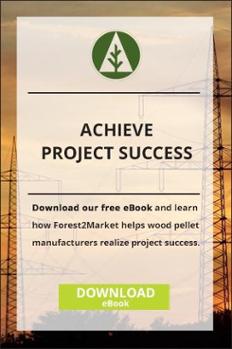2 min read
Choosing the Location of your Wood Pellet Manufacturing Facility
LeAndra Spicer : December 23, 2013
What is the current forest inventory and consumption in the supply shed?
It is necessary to distinguish between current forest inventory and the inventory available to consumers of wood raw materials. Physical reasons such as steep terrain or economic reasons like the cost of building adequate logging roads can preclude trees from harvest. As such, total forest inventory is not always synonymous with the supply available to commercial operations.
Commercially available timber is a function of both current forest inventory and the percentage of removals or harvests. To determine the latter, it is essential to identify the competitive facilities that consume wood raw materials from the supply shed. It is then necessary to quantify that consumption.
How do we grow the forest forward to forecast harvest volumes?
An accurate picture of future demand is best established by considering different scenarios unique to any one project and supply shed. In each demand scenario, it is critical to identify growth-to-drain ratios as a measure of sustainability. A positive ratio of 1.0 or greater must be maintained in order to ensure sustainable wood supply.
When harvest removals exceed forest growth, supply is constrained and price reaches a level where some consumers are forced to exit the market. These consumers are most often bioenergy facilities; long-established pulp and paper mills have a capacity to pay for raw material supply that far exceeds wood pellet mills.
Have loggers in the area adopted the technology needed to harvest and deliver woodfuel?
Woodchips must be dried before they can be manufactured into wood pellets. As such, wood pellet facilities require wood residues like woodfuel to dry raw materials like pulpwood. Loggers have no reason to engage in the expensive process of recovering wood residues when only small or no markets exist for this material.
What are current timber prices in the supply shed?
The cost of wood depends on demand and the number of trees available to meet that demand. For example, stumpage prices spike when new demand enters the market and puts pressure on current forest resources. Like forecasting future harvest volumes, differing demand scenarios are necessary to adequately forecast feedstock costs at start-up and into the future.
What are the logistics for feedstock delivery to the facility?
Details pertaining to logistics are easy to overlook but can ultimately have a major impact on successful facility operations. For instance, is a facility’s woodyard sufficient to receive the number of daily truckloads required to maintain a desired pellet output? Keep in mind, seasonal factors like wet weather can result in weeks or months of no logging and, subsequently, no deliveries.
Another logistics question involves the number of miles between a pellet facility and major roadways, rail lines and ports. Will the transport costs of moving a finished product to its final destination be reasonable enough to guarantee a profit? The answer to such a question can significantly influence where project developers locate their wood pellet plants.Keeping these factors in mind requires a deep understanding of the wood fiber supply chain. As the wood bioenergy industry grows, competition for wood fiber will intensify in local supply sheds. The onus is on project developers to achieve a comprehensive knowledge of supply chain and other operational issues that affect project bankability.
Comments
02-18-2014
I enjoyed your article. I recently spoke at an energy conference and spoke on 5 items necessary for a pellet mill:
Transportation/Logistics
Fiber Supply
Power
Infrastructure
Off Take Agreement or Sales Contract
I thought you would be interested in a different perspective.
Patrick Browne




